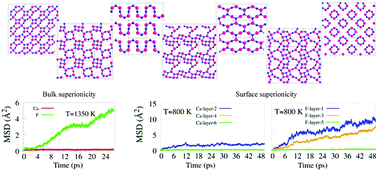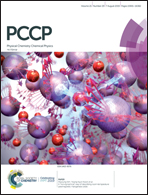Surface reconstructions and premelting of the (100) CaF2 surface
Abstract
In this work, surface reconstructions on the (100) surface of CaF2 are comprehensively investigated. The configurations were explored by employing the Minima Hopping Method (MHM) coupled to a machine-learning interatomic potential, that is based on a charge equilibration scheme steered by a neural network (CENT). The combination of these powerful methods revealed about 80 different morphologies for the (100) surface with very similar surface formation energies differing by not more than 0.3 J m−2. To take into account the effect of temperature on the dynamics of this surface as well as to study the solid–liquid transformation, molecular dynamics simulations were carried out in the canonical (NVT) ensemble. By analyzing the atomic mean-square displacements (MSD) of the surface layer in the temperature range of 300–1200 K, it was found that in the surface region the F sublattice is less stable and more diffusive than the Ca sublattice. Based on these results we demonstrate that not only a bulk system, but also a surface can exhibit a sublattice premelting that leads to superionicity. Both the surface sublattice premelting and surface premelting occur at temperatures considerably lower than the bulk values. The complex behaviour of the (100) surface is contrasted with the simpler behavior of other low index crystallographic surfaces.



 Please wait while we load your content...
Please wait while we load your content...